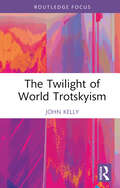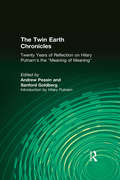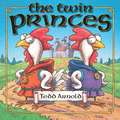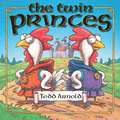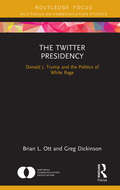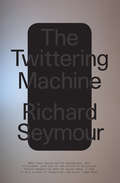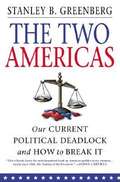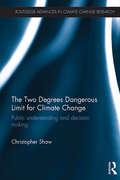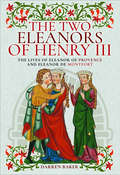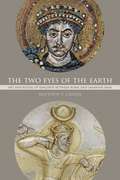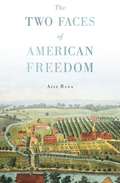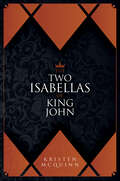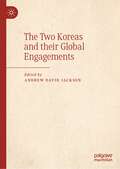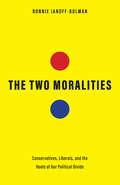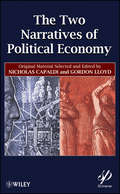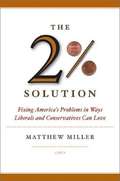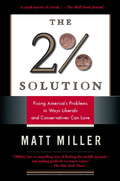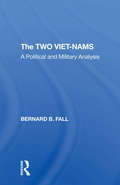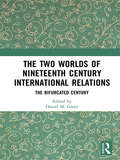- Table View
- List View
The Twilight of World Trotskyism (Routledge Studies in Radical History and Politics)
by John KellyThe Twilight of World Trotskyism analyzes the reasons behind the historic failure of the Trotskyist movement around the world. The book begins this assessment by briefly recapitulating the origins of Trotskyism, as a political current within the communist movement, and elaborating its major elements, before describing the historical development of Trotskyism in the four countries where it has sunk the deepest roots and which house the clear majority of the world’s Fourth Internationals: Argentina, Britain, France and the USA. It then proceeds to map the current state of the global Trotskyist movement. Whatever their current size and status, Trotskyist organizations aspire to become mass political parties and lead revolutionary seizures of power. It is therefore appropriate to examine them through the metrics applied to mainstream parties, namely organization, membership and political influence. The author looks at the dynamics of the Trotskyist movement, focusing in particular on the supposedly harmful effects of the communist movement before then turning to examine the role of Trotskyist organizations in the many revolutionary situations that have appeared since the 1920s and in the various ‘cycles of protest’ that have occurred in the latter half of the 20th century and the early years of the 21st century. The final section examines the two success stories frequently cited in Trotskyist literature, namely the cases of Bolivia and Sri Lanka. The book concludes by setting out and examining a wide variety of explanations for the chronic and sustained weaknesses of the Trotskyist movement, including its flawed appraisals of contemporary politics and economics, ultra-radical programmes and policies, failures in understanding the dynamics of protest and the baleful legacy of Soviet communism. It is argued that these weaknesses are rooted in Trotskyist doctrine and are therefore integral, not peripheral, features of world Trotskyism. This volume will be essential reading for activists and scholars interested in the transnational history and politics of the radical left.
The Twin Earth Chronicles: Twenty Years of Reflection on Hilary Putnam's the "Meaning of Meaning"
by Andrew Pessin Sanford GoldbergIn 1975, Putnam published a paper called The Meaning of 'Meaning', which challenged the orthodox view in the philosophies of language and mind. The article's Twin Earth conclusions about meaning, thought and knowledge were shocking. This work contains writings on the subject of Twin Earth.
The Twin Princes
by Tedd ArnoldRiddle me this . . . Why does Old King Chanticleer worry about his two sons, Henry and Fowler? Because they are twins, and he can't decide which prince should inherit his throne. And so he plans a horse race--one that will determine the next king. But this race is an unusual one, and it will take cleverness, not just speed, to become the winner. With puns on every page, the classic battle of hero versus villain, and even a riddle for the reader to solve, this featherbrained fairy tale is exuberant, goofy, irresistible fun.
The Twin Princes
by Tedd ArnoldWhy did Old King Chanticleer worry about his two sons? Because they were twins, and he could not decide which prince should inherit his throne. And so he planned a horse race-one that would determine the next king. But this race was an unusual one: The brother whose horse was last to cross the finish line would be the winner. How in the world could they finish this strange race? With puns on every page, exuberantly goofy artwork, the classic battle of hero versus villain, and even a riddle for the reader to solve, this featherbrained story is terrifically clever fun.
The Twitter Presidency: Donald J. Trump and the Politics of White Rage (NCA Focus on Communication Studies)
by Brian L. Ott Greg DickinsonThe Twitter Presidency explores the rhetorical style of President Donald J. Trump, attending to both his general manner of speaking as well as to his preferred modality. Trump’s manner, the authors argue, reflects an aesthetics of white rage, and it is rooted in authoritarianism, narcissism, and demagoguery. His preferred modality of speaking, namely through Twitter, effectively channels and transmits the affective dimensions of white rage by taking advantage of the platform’s defining characteristics, which include simplicity, impulsivity, and incivility. There is, then, a structural homology between Trump’s general communication practices and the specific platform (Twitter) he uses to communicate with his base. This commonality between communication practices and communication platform (manner and modality) struck a powerful emotive chord with his followers, who feel aggrieved at the decentering of white masculinity. In addition to charting the defining characteristics of Trump’s discourse, The Twitter Presidency exposes how Trump’s rhetorical style threatens democratic norms, principles, and institutions.
The Twittering Machine
by Richard SeymourA brilliant probe into the political and psychological effects of our changing relationship with social mediaFormer social media executives tell us that the system is an addiction-machine. We are users, waiting for our next hit as we like, comment and share. We write to the machine as individuals, but it responds by aggregating our fantasies, desires and frailties into data, and returning them to us as a commodity experience. The Twittering Machine is an unflinching view into the calamities of digital life: the circus of online trolling, flourishing alt-right subcultures, pervasive corporate surveillance, and the virtual data mines of Facebook and Google where we spend considerable portions of our free time. In this polemical tour de force, Richard Seymour shows how the digital world is changing the ways we speak, write, and think. Through journalism, psychoanalytic reflection and insights from users, developers, security experts and others, Seymour probes the human side of the machine, asking what we&’re getting out of it, and what we&’re getting into. Social media held out the promise that we could make our own history–to what extent did we choose the nightmare that it has become?
The Two Americas: Our Current Political Deadlock and How to Break It
by Stanley B. GreenbergThe 2000 presidential left the world standing still, but it was no fluke. America is divided right down the middle - the product of a half-century, unique in our country's history, of inconclusive, increasingly heated partisan battle. Tantalizingly close to victory, each party inflames and mobilizes its most loyal supporters and battles to gain even a small edge with some contested groups. Politics has become culture war - a fight about values, faith, the family, how people should live their lives. The result: partisans are more partisan, politics more polarized, America more divided. The Two Americas: Our Current Political Deadlock and How to Break It tells the history of each party's failed efforts to dominate the era's politics and ideas, radically changing the political landscape. The book provides an in-depth guide to the new groups at the center of our politics. Internationally renowned political strategist and pollster Stanley Greenberg puts the reader in the room with the strategists and politicians and shows how each party can win, even shatter the impasse. The Two Americas is a political primer and strategic playbook for this unique era - essential reading for any armchair political strategist or engaged citizen eager to understand our future politics.
The Two Churches: Catholicism and Capitalism in the World System
by Michael L. BuddeThe single most important change now well under way within Catholicism is its transition from a First World to a Third World entity. How this enormous shift will affect the Catholic church's role in the world economy is the subject of Michael L. Budde's book, the first world systems study of the mutual interaction of religion and political economy in the 1990s.Budde's argument here is twofold. He contends that world Catholicism, led by its Third World majority (most notably in Latin America), will continue to develop in an increasingly anticapitalist direction; and he suggests that once-dominant First World Catholic churches (exemplified by the U.S. Catholic church), are poorly placed to respond in solidarity with their coreligionists from the Third World.Covering a wide range of theoretical and substantive matters, The Two Churches examines religion as a source of both social legitimation and social rebellion. It demonstrates the importance of ecclesiology, a branch of theology dealing with "theories of the church," and it highlights the effect of capitalism on world Catholicism, as well as the latter's influence on the development of the capitalist order.In his original, far-reaching analysis of the Catholic church's role in world affairs, Budde revises current views of religious institutions as subordinate social phenomena. By relating developments in the world political economy to material conditions in the Third World and in turn to the practice of Catholicism, he reveals how the Catholic church functions as a worldwide institution. He also shows how core-periphery conflicts within the church affect transnational capitalism.As the Third World becomes more and more volatile, and as its relations with the First World further complicate the politics of the Catholic church, the questions addressed in The Two Churches demand attention with increasing urgency. Timely, thoughtful, and lucid, this book will inform and enhance our understanding of this complex, pressing issue.
The Two Degrees Dangerous Limit for Climate Change: Public Understanding and Decision Making (Routledge Advances in Climate Change Research)
by Christopher ShawThis book is about the history, present and future of one the most important policy ideas of the modern era – that there is a single, global dangerous amount of climate change. That dangerous amount of climate change is imagined as two degrees centigrade of global warming above the pre-industrial average. Though the two degree idea is based on the value system of elite policy actors, it is been constructed in public discourses as scientific fact. This false representation of the concept undermines opportunities for positive public engagement with the climate policy debate, yet it is strong public engagement which is a recurring aspiration of climate policy discourses and is considered essential if climate mitigation strategies are to work. Alongside a critical analysis of how the idea of a single dangerous limit has shaped our understanding of what sort of problem climate change is, the book explains how the public have been kept out of that decision making process, the implications of this marginalisation for climate policy and why the dangerous limit idea is undermining our ability to mitigate climate change. The book concludes by exploring possibilities for a deliberation about the future of the two degree limit which allows for public participation in the decision making process. This book illustrates why, at this critical juncture in the climate policy debate, the two degree limit idea has failed to achieve any of the policy goals intended. This is the first book dedicated to questioning the issue of the two degree limit within a social science framework and should be of interest to students and scholars of environmental policy and politics, climate change communication, and science, technology and society studies.
The Two Eleanors of Henry III: The Lives of Eleanor of Provence and Eleanor de Montfort
by Darren BakerThis account of two strong medieval women and their relationship &“thoroughly engrosses you in a story hundreds of years past&”(Seattle Book Review). Born in 1223, Eleanor of Provence has come to England at the age of twelve to marry the king, Henry III. He&’s sixteen years older, but was a boy when he ascended the throne. He&’s a kind, sensitive sort whose only personal attachments to women so far have been to his three sisters. The youngest of those sisters is called Eleanor too. She was only nine when, for political reasons, her first marriage took place, but she&’s already a chaste twenty-year-old widow when the new queen arrives in 1236. Soon, this Eleanor will marry the rising star of her brother&’s court, a French parvenu named Simon de Montfort, thus wedding the fates of these four people together in an England about to undergo some of the most profound changes in its history. The Two Eleanors of Henry III is a tale that spans decades, with loyalty to family and principles at stake, in a land where foreigners are subject to intense scrutiny and jealousy. The relationship between these two sisters-in-law, close but ultimately doomed, reflects not just the turbulence and tragedy of their times, but also the brilliance and splendor.
The Two Eleanors of Henry III: The Lives of Eleanor of Provence and Eleanor de Montfort
by Darren BakerThis account of two strong medieval women and their relationship &“thoroughly engrosses you in a story hundreds of years past&”(Seattle Book Review). Born in 1223, Eleanor of Provence has come to England at the age of twelve to marry the king, Henry III. He&’s sixteen years older, but was a boy when he ascended the throne. He&’s a kind, sensitive sort whose only personal attachments to women so far have been to his three sisters. The youngest of those sisters is called Eleanor too. She was only nine when, for political reasons, her first marriage took place, but she&’s already a chaste twenty-year-old widow when the new queen arrives in 1236. Soon, this Eleanor will marry the rising star of her brother&’s court, a French parvenu named Simon de Montfort, thus wedding the fates of these four people together in an England about to undergo some of the most profound changes in its history. The Two Eleanors of Henry III is a tale that spans decades, with loyalty to family and principles at stake, in a land where foreigners are subject to intense scrutiny and jealousy. The relationship between these two sisters-in-law, close but ultimately doomed, reflects not just the turbulence and tragedy of their times, but also the brilliance and splendor.
The Two Eyes of the Earth: Art and Ritual of Kingship between Rome and Sasanian Iran
by Matthew P. CanepaThis pioneering study examines a pivotal period in the history of Europe and the Near East and investigates the shared ideal of sacred kingship that emerged in the late Roman and Persian empires and explores the artistic, ritual, and ideological interactions between Rome and the Iranian world under the Sasanian dynasty.
The Two Faces of American Freedom
by Aziz RanaThe Two Faces of American Freedom reinterprets the American political tradition from the colonial period to modern times, placing issues of race relations, immigration, and presidentialism in the context of shifting notions of empire and citizenship. Rana envisions a democratic society that revives settler ideals, but combines them with meaningful inclusion for those currently at the margins of American life.
The Two Faces of American Freedom
by Aziz RanaThe Two Faces of American Freedom boldly reinterprets the American political tradition from the colonial period to modern times, placing issues of race relations, immigration, and presidentialism in the context of shifting notions of empire and citizenship. Today, while the U.S. enjoys tremendous military and economic power, citizens are increasingly insulated from everyday decision-making. This was not always the case. America, Aziz Rana argues, began as a settler society grounded in an ideal of freedom as the exercise of continuous self-rule—one that joined direct political participation with economic independence. However, this vision of freedom was politically bound to the subordination of marginalized groups, especially slaves, Native Americans, and women. These practices of liberty and exclusion were not separate currents, but rather two sides of the same coin. However, at crucial moments, social movements sought to imagine freedom without either subordination or empire. By the mid-twentieth century, these efforts failed, resulting in the rise of hierarchical state and corporate institutions. This new framework presented national and economic security as society’s guiding commitments and nurtured a continual extension of America’s global reach. Rana envisions a democratic society that revives settler ideals, but combines them with meaningful inclusion for those currently at the margins of American life.
The Two Faces of Judicial Power: Dynamics of Judicial-Political Bargaining
by Benjamin G. EngstThis book shows that constitutional courts exercise direct and indirect power on political branches through decision-making. The first face of judicial power is characterized by courts directing political actors to implement judicial decisions in specific ways. The second face leads political actors to anticipate judicial review and draft policies accordingly. The judicial–political interaction originating from both faces is herein formally modeled. A cross-European comparison of pre-conditions of judicial power shows that the German Federal Constitutional Court is a well-suited representative case for a quantitative assessment of judicial power. Multinomial logistic regressions show that the court uses directives when evasion of decisions is costly while accounting for the government’s ability to implement decisions. Causal analyses of the second face of judicial power show that bills exposed to legal signals are drafted accounting for the court. These findings re-shape our understanding of judicialization and shed light on a silent form of judicialization.
The Two Hendricks: Unraveling a Mohawk Mystery
by Eric HinderakerIn September 1755, the most famous Indian in the world—a Mohawk leader known in English as King Hendrick—died in the Battle of Lake George. He was fighting the French in defense of British claims to North America, and his death marked the end of an era in Anglo-Iroquois relations. He was not the first Mohawk of that name to attract international attention. Half a century earlier, another Hendrick worked with powerful leaders in the frontier town of Albany. He cemented his transatlantic fame when he traveled to London as one of the “four Indian kings.”Until recently the two Hendricks were thought to be the same person. Eric Hinderaker sets the record straight, reconstructing the lives of these two men in a compelling narrative that reveals the complexities of the Anglo-Iroquois alliance, a cornerstone of Britain’s imperial vision. The two Hendricks became famous because, as Mohawks, they were members of the Iroquois confederacy and colonial leaders believed the Iroquois held the balance of power in the Northeast. As warriors, the two Hendricks aided Britain against the French; as Christians, they adopted the trappings of civility; as sachems, they stressed cooperation rather than bloody confrontation with New York and Great Britain.Yet the alliance was never more than a mixed blessing for the two Hendricks and the Iroquois. Hinderaker offers a poignant personal story that restores the lost individuality of the two Hendricks while illuminating the tumultuous imperial struggle for North America.
The Two Isabellas of King John
by Kristen McQuinnKing John of England was married to two women: Isabella of Gloucester and Isabelle of Angoulême. The two women were central to shaping John and his reign, each in her own way molding the king and each other over their lives. Little is known about Isabella of Gloucester and she has largely become an historical footnote; Isabelle of Angoulême has a reputation as a witch and poisoner. However, both were products of their time, victims and pawns of the powerful men whose voices overwrote the experiences of women. By examining these two very different women through a modern feminist lens, The Two Isabellas offers new insight into one of England’s lesser-known queens and a different interpretation of one of its least popular kings. In The Two Isabellas of King John, Kristen McQuinn offers new and intriguing insights into two of England’s important yet little understood queen-consorts, the wives of King John. Taking a feminist light, McQuinn brightly shines it on both England’s least well-known consort, Isabella of Gloucester, his first wife, and one of its least popular, Isabelle of Angoulême, his child bride.
The Two Koreas and their Global Engagements
by Andrew David JacksonThis book departs from existing studies by focusing on the impact of international influences on the society, culture, and language of both North and South Korea. Since President Kim Young Sam’s segyehwa drive of the mid-1990s, South Korea has become a model for successful globalization. In contrast, North Korea is commonly considered one of the least internationally integrated countries. This characterization fails to account for the reality of the two Koreas and their global engagements. The opening essay situates the chapters by highlighting some significant contrasts and commonalities between the experiences of North and South Korea’s history of engagement with the world beyond the Peninsula. The chapters explore both the longer-term historical influence of Korea’s international contacts as well as specific Korean cultural, linguistic, and social developments that have occurred since the 1990s demise of the global Cold War and greater international integration.
The Two Logics of Autocratic Rule
by Johannes GerschewskiIn The Two Logics of Autocratic Rule, Gerschewski argues that all autocracies must fulfil three conditions to survive: the co-optation of key elites into their inner sanctum, the repression of potential dissent, and popular legitimation. Yet, how these conditions complement each other depends on alternative logics: over-politicization and de-politicization. While the former aims at mobilizing people via inflating a friend-foe distinction, the latter renders the people passive and apathetic, relying instead on performance-driven forms of legitimation. Gerschewski supports this two-logics theory with the empirical analysis of forty-five autocratic regime episodes in East Asia since the end of World War II. In simultaneously synthesizing and extending existing research on non-democracies, this book proposes an innovative way to understand autocratic rule that goes beyond the classic distinction between totalitarian and authoritarian regimes. It will be of interest to scholars and students of comparative politics, political theory, and East Asian politics.
The Two Moralities: Conservatives, Liberals, and the Roots of Our Political Divide
by Ronnie Janoff-BulmanThe most complete picture to date of the moral worlds of the political left and right and how their different views relate to specific political issues The left and right will always have strong policy disagreements, but constructive debate and negotiation are not possible when each side demonizes the other. We need to move past our poisonous politics. In this book, social psychologist Ronnie Janoff-Bulman provides a new framework for understanding why and how we disagree. Janoff-Bulman asks readers to consider the challenging possibility that both liberalism and conservatism are morally based and reflect genuine concern for the country. Moral psychology is an invaluable lens for understanding the roots of political differences. She presents a &“Model of Moral Motives&” that maps the most fundamental motivations recognized by psychology—approach and avoidance—onto these differences. Liberal morality focuses on providing for the group&’s well-being and ensuring social justice. Conservative morality focuses on protecting the group from threats and preserving order. These moralities can account for the psychological differences between liberals and conservatives and for why certain positions resonate on each side of the political spectrum. Why, for example, do conservatives oppose abortion and favor unfettered free markets while liberals favor a woman&’s right to choose and economic regulation? Understanding that our political differences are rooted in two natural forms of morality can help us begin to detoxify our politics.
The Two Narratives of Political Economy
by Nicholas Capaldi Gordon LloydCaptures the 17th-19th century origins and developments ofpolitical economy by editing original texts and illuminatingtheir relevance for today's political debate Political economy from the 17th century to the present can be captured in two narratives originating with Locke and Rousseau. Those original narratives were expanded in significant ways in the 18th and 19th centuries, and the editors argue that they still hold sway today. Edited original writings included in the anthology are from: Locke, Rousseau, Adam Smith, Tocqueville, Mill, Marx, Proudhon, Owen, the Federalist Papers, the French Declaration of the Rights of Man and the Citizen, and the American Constitution. The editors have restricted their comments to the extensive introductions thereby allowing the original participants to speak for themselves. The readings included are intended to be instructive with respect to the origin and development of the two narratives rather than an exhaustive account of how thinkers and writers on economics advance the discipline of economics as a social science. Reviews "The editors provide a compelling collection to critically frame the clash of Political Economy which shapes modern democracies. Their selections and introductions expertly paint a picture of the contending schools to suggest how enduring these core challenges remain. By placing these writers within this great debate, the authors guide students to discover the essential questions of liberty, equality, and the proper role of the state at the core of the American economic debate." —Roberta Q. Herzberg, Utah State University Political Science "The real service performed by Capaldi and Lloyd is to provide generous excerpts from supporters of both narratives so that the reader can determine for themselves who best makes their case. I recommend this volume highly both to the individual interested in learning about the intellectual and political history of political economy and to the professor in search of a one-volume anthology on political economy for use in a course on economic thought." —Steven D. Ealy, Senior Fellow, Liberty Fund, Inc.
The Two Percent Solution: Fixing America's Problems In Ways Liberals And Conservatives Can Love
by Matthew MillerSuppose someone told you that for just two cents on the national dollar we could have a country where everyone had health insurance, full-time workers earned a living wage, poor children had great teachers in fixed-up schools, and politicians no longer had to grovel to wealthy donors. And suppose that when we were done, government would still be smaller than it was when Ronald Reagan was president. If you're like most people, you'd probably think that for two cents on the dollar this sounds like an intriguing deal. But 2 percent of America's GDP is more than 200 billion a year--way beyond what politicians in Washington think is possible. <P><P> Between our proper intuition that 2 percent is a small amount, and the Washington consensus that a 2 percent shift in priorities is beyond imagining, lies the opportunity to transform American politics. In this agenda-setting book, Matthew Miller challenges our country (and those who would lead it) to change the way we think about our public responsibilities before the baby boomers' retirement siphons all the money out of the system. The Two Percent Solution is a call to arms that no serious candidate, Republican or Democrat, can afford to ignore.
The Two Percent Solution: Fixing America's Problems In Ways Liberals And Conservatives Can Love
by Matthew MillerConsultant, columnist, and public radio commentator Miller calls for increasing the national government budget from 20% to 22% of gross domestic product, and using the additional income for the public good. He urges readers to urge their leaders to do it. Annotation (c)2003 Book News, Inc. , Portland, OR (booknews. com)
The Two Vietnams: A Political And Military Analysis
by Bernard FallThis book is devoted to a comparison of the governmental and economic institutions of north and south zones of Viet-Nam; that each zone has its own set of economic and political troubles and that both sides are engaged in military efforts which may well overwhelm them in the end.
The Two Worlds of Nineteenth Century International Relations: The Bifurcated Century
by Daniel M GreenThis edited volume presents a new, grand and global narrative for international relations (IR) history in the pivotal nineteenth century. Typically considered by IR scholars to be a long century of relative peace after 1815, the contributors offer a reconceptualization of IR in this century, arguing that it is temporally bifurcated, with very different patterns of behavior in the first and second halves. A mid-century discontinuity – a "pivot period" – marks the transition phase in Europe and globally when, in the space of a few years, a shift occurred from a comparatively calm, politically disconnected world under loose British free trade hegemony to one of scrambles for territory and keen interest in imperial possessions and conquest. All the book’s chapters deal with characterizing patterns of relations in the first half of the century or the second, with two addressing the discontinuity in the middle. In the first half aspects of regional orders are described (in Latin America, East Asia and Europe) alongside crucial developmental processes (missionaries and colonial expansion, the agency of regionally localized actors, of leading elites). In the second half, there is again discussion of regional developments (East Asia, Europe), but now under the onslaught and pressures of the latter half of the century, and spotlighting industrialization’s impact and the role of status competition and international law. In presenting this new narrative for the nineteenth century, it becomes clear that an era long considered uninteresting on Eurocentric grounds is in fact crucial and pivotal in global terms. This work will be of particular interest to students and scholars of the history of international relations.
